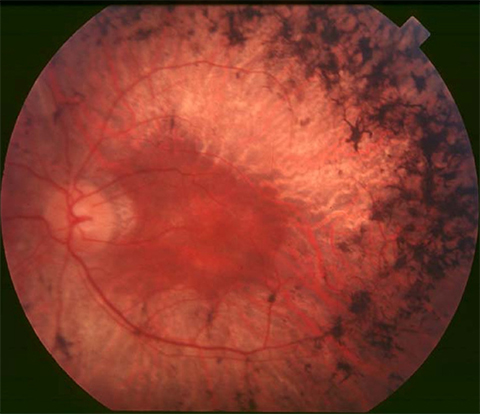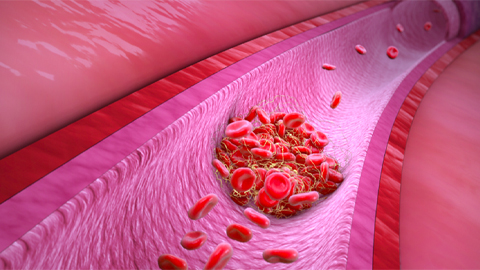An unexpected component in retinal survival
At the back of the eyeball, in the retina, photoreceptor cells convert light into electrical signals that are sent to the brain for processing. When these photoreceptors degenerate, vision can become impaired, and conditions such as macular degeneration and retinitis pigmentosa sometimes develop. Blindness may result.
In a recent study published in the Journal of Lipid Research, researchers at the National Eye Institute describe how they discovered the importance of a membrane-linked receptor protein called pigment epithelium-derived factor receptor, or PEDF-R, in photoreceptor structure and function and, ultimately, in retinal survival.

Alexandra Bernardo Colón, a biologist at the National Eye Institute, works in Patricia Becerra’s lab, where they focus on retinal degeneration. They aim to understand factors that can play a role in preventing photoreceptor cell death, including PEDF, a protein that helps protect the retina by interacting with PEDF-R to spur its phospholipase activity.
Bernardo Colón became interested in PEDF-R due to this phospholipase activity. Photoreceptors, which are rich in phospholipids, produce PEDF-R, and, upon binding of PEDF, PEDF-R catalyzes the hydrolysis of phospholipids and triglycerides.
“Phospholipid metabolism is really critical for the homeostasis of photoreceptors and health of the retina,” Bernardo Colón said. “What is unclear is whether PEDF-R, as a phospholipase, is a molecular link between phospholipids and the photoreceptor survival, so that’s why this is intriguing.”
This receptor is usually called adipose triglyceride lipase, or ATGL, but Bernardo Colón believes her term is more accurate in the field of eye health. “We are calling it PEDF-R because it’s not just found in the adipose tissue,” she said. “We found that we can see it in the entire retina.”
To investigate the role of PEDF-R in photoreceptor structure, the team used CRISPR technology to knock out Pnpla2, the gene encoding for PEDF-R, in mice. They also ensured that known mutations causing retinal degeneration were not present. They found that mice deficient in PEDF-R had photoreceptor deformities, such as smaller thickness of multiple retinal layers and unevenly arranged outer segments, and accumulation of two main retinal phospholipids.
“We’re suggesting a causal link to photoreceptor dysfunction,” Bernardo Colón said.
PEDF-R deficiency caused decreases in both mRNA and immunofluorescence levels of rhodopsin and opsin, which are the photoreceptor cells that help detect light.
The team then performed an electroretinogram to measure how different cells in the retina, including photoreceptors, responded to light. They found that missing just one copy of the Pnpla2 gene compromised photoreceptor function and missing both was even more detrimental.
Overall, the researchers noted that PEDF-R plays a crucial role in photoreceptor structure and function as well as phospholipid metabolism. They also underlined the fact that all layers of the retina are interconnected.
“When one layer malfunctions, all of the other layers will follow,” Bernardo Colón said, “so if PEDF-R is not functioning, eventually all of the other layers of the retina will not function as well.”
Ultimately, this research team hopes to develop drugs to ensure retinal survival and combat blindness, with phospholipid metabolism as a potential therapeutic target.
Enjoy reading ASBMB Today?
Become a member to receive the print edition monthly and the digital edition weekly.
Learn moreGet the latest from ASBMB Today
Enter your email address, and we’ll send you a weekly email with recent articles, interviews and more.
Latest in Science
Science highlights or most popular articles
Universal tool for tracking cell-to-cell interactions
A team of researchers has developed LIPSTIC, which can lay the groundwork for a dynamic map tracking physical interactions between different cells — the elusive cellular interactome.

Weedy rice gets competitive boost from its wild neighbors
Rice feeds the world. But researchers have found that a look-alike weed has many ways of getting ahead.

From the journals: JLR
A “T” makes a difference in blood clotting. High cholesterol: two screens are better than one. Biomarkers for cardiovascular risk. Statin-induced changes to the HDL lipidome. Read about recent papers on these topics.

Decoding microglial language
Emory University scientists characterize extracellular vesicles that facilitate intercellular communication.

What is metabolism?
A biochemist explains how different people convert energy differently – and why that matters for your health.

What’s next in the Ozempic era?
Diabetes, weight loss and now heart health: A new family of drugs is changing the way scientists are thinking about obesity — and more uses are on the horizon.

